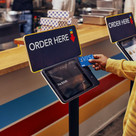Table of contents
As we enter the holiday shopping season, retailers are planning for all scenarios.
Stores may close temporarily or have reduced capacity, while curbside pickup and delivery are likely to become even more popular. eCommerce websites are going to play a bigger role than they have in seasons past, and social media platforms will become a key place to connect with customers.
While shoppers may not ask for it by name, omnichannel retail is what they want. Eighty percent of customers expect a consistent experience across all of a retailer’s channels, according to research from Salesforce. And businesses that do it well retain on average 89% of their customers, reports Forbes.
So, how do you pull this off?
Your online and in-person stores should be complementary
Online shopping was already popular before COVID-19. In fact, Google found that 56% of people’s time spent shopping happens online. This holiday season, that number is only going to grow.
Use SEO
Optimize your website for search engines so shoppers can find your business and products. If you have a physical store location, SEO can help here, too.
- Make sure your address and store name appear correctly across search results.
- Claim and verify your business listings on Google and Yelp.
- Double-check that your holiday business hours are correct, and that you indicate when you’re open for all the ways you sell, like delivery and pickup.
If a shopper finds you online and wants to visit your store, up-to-date information will make it easier.
Diversify sales channels
Increase sales by using eCommerce tools on your social media platforms. These channels are not only a great way for customers to find your business, but they can also also help people discover your individual products.
About 55% of consumers have made purchases through social media channels like Facebook, Instagram, and Pinterest, according to Retail Dive. Each platform offers tools to direct traffic to your retail website or product pages, or to complete the purchase directly on your social media page.
Stay consistent
Tie in your brand messaging
Whether your customers are shopping on Instagram or visiting your brick-and-mortar store, your brand messaging should stay the same. For example, your in-store promotion copy should match up with how you talk about those same promotions on your social media platforms.
You can also extend your brand messaging through your interactions with online customers. Chat and video tools can bridge the divide that social distancing creates, helping you develop a relationship with your customer base that makes sense for your brand. Make it easy for customers to reach out online or schedule a video conference if you sell items that require more guidance.
Sync your inventory
By offering multiple purchasing channels, shoppers can have more than one way to buy a product from you. That means your inventory needs to be in sync everywhere you sell, so buyers aren’t disappointed. Smart inventory management also helps you keep track of sales across channels, no matter how they’re fulfilled.
Share how much product you have, along with details explaining how shoppers can reserve or buy an item online before they head to the store to pick it up. Providing a variety of options will help customers choose the delivery or pickup method that’s most convenient for them.
Keep your prices the same
Some eCommerce websites take advantage of dynamic pricing, which can adjust the amount of an item based on various factors. With omnichannel selling, however, your customers want consistency. Be sure your offers and promotions are the same, no matter where a customer discovers your products.
Ninety percent of consumers say they use their smartphones while shopping in-store, comparing prices and looking up product information, according to Retail Touchpoints. And more than three-quarters of consumers are likely to choose a retailer offering pricing and promotions that are the same across channels.
While you can offer personalized promotions, your catalog should have consistent pricing to prevent shoppers from having buyer’s remorse.
Omnichannel retail and the future
An omnichannel retail strategy can help you address the challenges of today’s world. Whether your business is online-only, brick-and-mortar, or click-and-mortar, your customers crave consistency. And it’s your job to deliver that everywhere you sell. Switching your POS system to an all-in-one solution that makes it easy to manage your business however you sell can make all the difference.
As we adapt to the unknowns of this year’s holiday shopping season, providing customers with a connected and familiar experience can become a welcome constant in a time of uncertainty.
![]()













